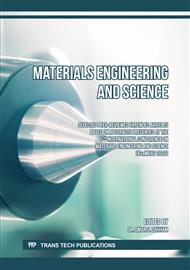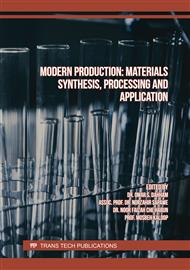[1]
Price, Willard, and Edgar D. Smith., Waste tire recycling: environmental benefits and commercial challenges, International Journal of Environmental Technology and Management 6, no. 3-4 (2006) 362-374.
DOI: 10.1504/ijetm.2006.009001
Google Scholar
[2]
Li, Functions., Impacts of plastic/rubber wastes as eco-friendly aggregate in concrete–a review, Construction and Building Materials 240.
DOI: 10.1016/j.conbuildmat.2019.117869
Google Scholar
[3]
Mohammed, Bashar S., Musa Adamu, and Nasir Shafiq., A review on the effect of crumb rubber on the properties of rubbercrete, International Journal of Civil Engineering and Technology 8, no. 9 (2017) 599-615.
Google Scholar
[4]
Thomas, Blessen Skariah, Sanjeev Kumar, Priyansha Mehra, Ramesh Chandra Gupta, Miquel Joseph, and Laszlo J. Csetenyi., Abrasion resistance of sustainable green concrete containing waste tire rubber particles, Construction and Building Materials 124 (2016) 906-909.
DOI: 10.1016/j.conbuildmat.2016.07.110
Google Scholar
[5]
Hejna, Aleksander, Jerzy Korol, Marta Przybysz-Romatowska, Łukasz Zedler, Błażej Chmielnicki, and Krzysztof Formela, Waste tire rubber as low-cost and environmentally-friendly modifier in thermoset polymers–A review, Waste Management 108 (2020) 106-118.
DOI: 10.1016/j.wasman.2020.04.032
Google Scholar
[6]
Ramarad, S., M. Khalid, C. T. Ratnam, A. Luqman Chuah, and W. Rashmi. , Waste tire rubber in polymer blends: A review on the evolution, properties and future, Progress in Materials Science 72 (2015) 100-140.
DOI: 10.1016/j.pmatsci.2015.02.004
Google Scholar
[7]
Wang, Y. E. H., Feng‐C. Yeh, Sun‐M. Lai, Hsun‐C. Chan, and Hsiao‐F. Shen., Effectiveness of functionalized polyolefins as compatibilizers for polyethylene/wood flour composites, Polymer Engineering & Science 43, no. 4 (2003) 933-945.
DOI: 10.1002/pen.10077
Google Scholar
[8]
Aoudia, Karima, Saïd Azem, Nourredine Aït Hocine, Michel Gratton, Valeria Pettarin, and Saïd Seghar., Recycling of waste tire rubber: Microwave devulcanization and incorporation in a thermoset resin, Waste management 60 (2017) 471-481.
DOI: 10.1016/j.wasman.2016.10.051
Google Scholar
[9]
De Sousa, Fabiula DB, Carlos H. Scuracchio, Guo-Hua Hu, and Sandrine Hoppe., Devulcanization of waste tire rubber by microwaves, Polymer Degradation and Stability 138 (2017) 169-181.
DOI: 10.1016/j.polymdegradstab.2017.03.008
Google Scholar
[10]
Karger-Kocsis, J., L. Mészáros, and T. Bárány., Ground tyre rubber (GTR) in thermoplastics, thermosets, and rubbers, Journal of Materials Science 48, no. 1 (2013) 1- 38.
DOI: 10.1007/s10853-012-6564-2
Google Scholar
[11]
Xie, Yanjun, Callum AS Hill, Zefang Xiao, Holger Militz, and Carsten Mai., Silane coupling agents used for natural fiber/polymer composites: A review, Composites Part A: Applied Science and Manufacturing 41, no. 7 (2010) 806-819.
DOI: 10.1016/j.compositesa.2010.03.005
Google Scholar
[12]
Shokoohi, Shirin, Ahmad Arefazar, and Ramin Khosrokhavar., Silane coupling agents in polymer-based reinforced composites: a review, Journal of Reinforced Plastics and Composites 27, no. 5 (2008) 473-485.
DOI: 10.1177/0731684407081391
Google Scholar
[13]
Kaynak, Cevdet, Cengiz Celikbilek, and Guneri Akovali., Use of silane coupling agents to improve epoxy–rubber interface." European Polymer Journal 39, no. 6 (2003) 1125-1132.
DOI: 10.1016/s0014-3057(02)00381-6
Google Scholar
[14]
Kaynak, Cevdet, E. Sipahi-Saglam, and G. Akovali., A fractographic study on toughening of epoxy resin using ground tyre rubber, Polymer 42, no. 9 (2001) 4393-4399.
DOI: 10.1016/s0032-3861(00)00734-5
Google Scholar
[15]
Karabork, Fazliye, Erol Pehlivan, and Ahmet Akdemir., Characterization of styrene butadiene rubber and microwave devulcanized ground tire rubber composites, Journal of Polymer Engineering 34, no. 6 (2014): 543-554.
DOI: 10.1515/polyeng-2013-0330
Google Scholar
[16]
Kim, Jin‐Tae, Dong‐Yeoul Lee, Taeg‐Su Oh, and Dong‐Ho Lee., Characteristics of nitrile–butadiene rubber layered silicate nanocomposites with silane coupling agent, Journal of Applied Polymer Science 89, no. 10 (2003) 2633-2640.
DOI: 10.1002/app.12169
Google Scholar
[18]
Nandiyanto, Asep Bayu Dani, Rosi Oktiani, and Risti Ragadhita. ,How to read and interpret FTIR spectroscope of organic material, Indonesian Journal of Science and Technology 4, no. 1 (2019) 97-118.
DOI: 10.17509/ijost.v4i1.15806
Google Scholar



